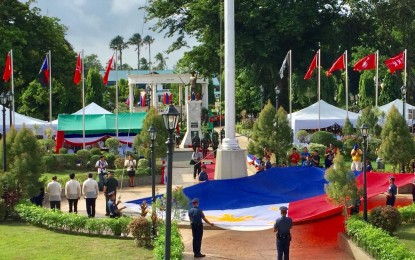
ONE OF THE COUNTRY'S BIGGEST FLAGS. Iloilo local officials and guests prepare to hoist one of the country's biggest flags during the celebration of the 120th Independence Day in Sta. Barbara, Iloilo on Tuesday (June 12, 2018). (Photo by Cindy Ferrer)
ILOILO CITY -- The country’s flag has become “commonplace that Filipinos in the 21st century see them every day but hardly notice,” said Professor Ambeth Ocampo in Sta. Barbara, Iloilo on Tuesday.
Ilonggos joined Ocampo in the flag-raising ceremony in celebration of the 120th Independence Day of the Philippines. The former chairman of the National Historical Commission of the Philippines (NHCP) and the National Commission for Culture and the Arts (NCCA) was the guest of honor for the celebration.
Ocampo reminded the people of how significant the country’s flag is as it “rallied people in the many struggles for freedom and independence.”
“We must remember that this flag rallies us not so much to go back into the past but rather to forge confidently into the future,” he said.
Ocampo said that the flag which we inherited from Kawit, Cavite in the afternoon of June 12, 1898 has become ordinary for the present generation of Filipinos.
“We see flags everyday but we hardly noticed. At worse, flags are disrespected,” he said.
He cited some instances such as the Philippine flag being used as towel by Filipino athletes competing overseas or in a video that went viral because it was used as a mop.
Oftentimes, teachers and textbooks are blamed for ignorance of the flag’s history or the confusion that arises from the different meanings into its colors and symbols over the century, Ocampo added.
He recalled that the first Philippine flag was made in Hongkong in 1898, which was hand-sewn and embroidered by Marcela Agoncillo, following Emilio Aguinaldo’s design.
But the original flag, he said, is now lost. The contemporary one made of cotton, which was once displayed in Kawit, Cavite is now preserved in a private museum in Baguio City.
Ocampo said that the red in the Philippine flag is a symbol of Filipino courage while the color blue carries an allegorical meaning that all Filipinos will prefer to die before submitting ourselves to the invader.
Meanwhile, the white color conveys the idea that like other nations, Filipinos know how to govern themselves and that they do not recede from observation of foreign powers.
“Red, white, blue are the colors identified in the Constitution for the Philippine flag and I have fought a losing battle for an amendment to the constitution that will state that the sun should be golden or yellow,” he said.
Ocampo added that the sun and its eight rays are now the “light which brightens every spot in the Philippine islands.”
“A national flag can include and exclude depending on how it is read. Going back into its history reminds us that it was meant to unite an archipelago with many people and languages and cultures into one nation,” he added.
The celebration started with the hoisting of the giant Philippine flag measuring 30 feet by 60 feet and raised up on a 120-foot flagpole in front of the municipal hall
The flag-ceremony was joined by Governor Arthur Defensor Sr.; Sta. Barbara Mayor Dennis Superficial; Brigadier General Francisco Delfin, Assistant Division Commander of the Philippine Army’s 3rd Infantry Division based in Jamindan, Capiz; and Chief Superintendent John Bulalacao, Regional Director of Police Regional Office in Western Visayas.
Sta. Barbara is known to be the first town outside of Luzon to declare Independence from Spain in 1898 after General Martin Delgado led the revolution in Visayas and Mindanao during the Spanish colonization.
Over the years, the town of Sta. Barbara is annually hosting the celebration of Independence Day in Iloilo province.
In 2015, it hosted the national celebration of the 117th Independence Day with former president Benigno Aquino III as guest.
The giant flag is permanently hoisted at the town as mandated by the NHCP. (PNA)
